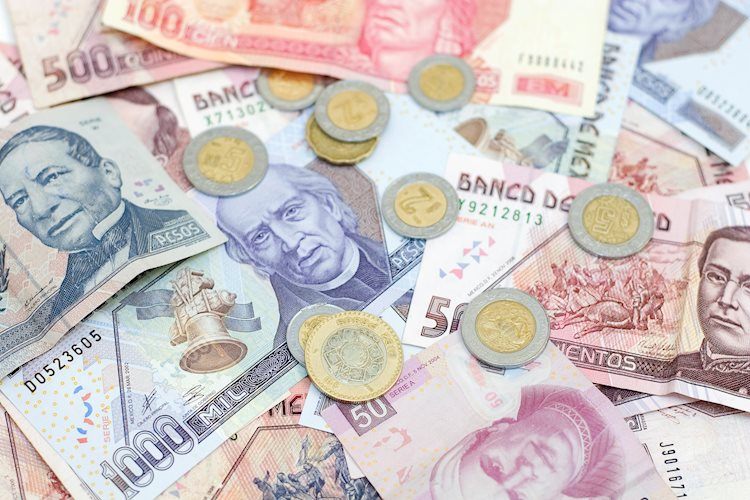- Mexican Peso on the backfoot following last week near 4% appreciation.
- President AMLO signs the judicial reform into law, officially enacted as of Sunday.
- Fed rate cut expectations rise, with a 61% chance of a 50 bps cut on Wednesday, as investors await key US Retail Sales data.
The Mexican Peso retreats moderately against the Greenback during Monday’s session amid thin trading due to Mexico’s closed local markets in observance of Independence Day. At the time of writing, the USD/MXN trades at 19.24, with gains of 0.35%.
The stock market mood is mixed on Wall Street and weighed on the Mexican currency, which appreciated close to 4% last week. A light economic docket in Mexico will feature the release of Aggregate Demand and Private Spending data for the second quarter of 2024 on Wednesday.
In the meantime, President Andres Manuel Lopez Obrador (AMLO) signed into law the Judicial reform, “took effect on Sunday after the text of the constitutional changes was published in the government gazette,” according to Reuters.
Across the north of the border, the US Dollar remains weak as investors brace for the first Federal Reserve (Fed) interest rate cut on Wednesday. Expectations that the Fed would go big with its first rate cut grew during Monday’s session after a news article of Fed whisperer Nick Timiraous hinted at the Fed’s dilemma of starting big or small.
Data from the CME FedWatch Tool shows odds for a 50-basis-point (bps) cut are at 61%, while for a 25 bps, they diminished from 50% last Friday to 39%.
Ahead of the week, the US economic schedule will feature August Retail Sales on Tuesday, which are expected to dip compared to July’s strong figures. This and housing data will be announced before the Fed’s decision and Chair Jerome Powell’s press conference.
Daily digest market movers: Mexican Peso weakens on Independence Day
- USD/MXN would continue to be driven by market mood and expectations for a bigger Fed rate cut.
- Mexico’s Inflation dipped below 5% in August, increasing the chances of additional easing by Banxico.
- Bank of Mexico Director of Economic Research, Alejandria Salcedo, said that a robust rule of law environment could generate conditions that encourage investment.
- Wall Street economists estimate that US Retail Sales will dip from 1% to 0.2% MoM.
- US Industrial Production is foreseen improving from July’s -0.6% contraction to 0%.
- Data from the Chicago Board of Trade suggests the Fed will cut at least 112 basis points this year, according to the fed funds rate futures contract for December 2024.
USD/MXN technical outlook: Mexican Peso drops as USD/MXN rises above 19.20
The USD/MXN pullback pushed the pair toward 19.15 before dip buyers emerged and pushed the spot price toward 19.38 before retreating somewhat. Momentum hints that sellers are in charge, but the Relative Strength Index (RSI) about to cross above its neutral line, could pave the way for a leg-up.
In that event, the USD/MXN’s next resistance level would be 19.50. On further strength, the next ceiling would be 20.00. Conversely, if USD/MXN extends its losses past 19.15, the 19.02 August 23 low will be within reach. A breach of the latter will expose the 50-day Simple Moving Average (SMA) at 18.99, followed by the August 19 cycle low of 18.59.
Banxico FAQs
The Bank of Mexico, also known as Banxico, is the country’s central bank. Its mission is to preserve the value of Mexico’s currency, the Mexican Peso (MXN), and to set the monetary policy. To this end, its main objective is to maintain low and stable inflation within target levels – at or close to its target of 3%, the midpoint in a tolerance band of between 2% and 4%.
The main tool of the Banxico to guide monetary policy is by setting interest rates. When inflation is above target, the bank will attempt to tame it by raising rates, making it more expensive for households and businesses to borrow money and thus cooling the economy. Higher interest rates are generally positive for the Mexican Peso (MXN) as they lead to higher yields, making the country a more attractive place for investors. On the contrary, lower interest rates tend to weaken MXN. The rate differential with the USD, or how the Banxico is expected to set interest rates compared with the US Federal Reserve (Fed), is a key factor.
Banxico meets eight times a year, and its monetary policy is greatly influenced by decisions of the US Federal Reserve (Fed). Therefore, the central bank’s decision-making committee usually gathers a week after the Fed. In doing so, Banxico reacts and sometimes anticipates monetary policy measures set by the Federal Reserve. For example, after the Covid-19 pandemic, before the Fed raised rates, Banxico did it first in an attempt to diminish the chances of a substantial depreciation of the Mexican Peso (MXN) and to prevent capital outflows that could destabilize the country.
Read the full article here

